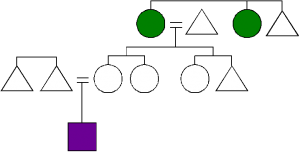![]()
![]()
![]()
![]()
![]()
![]()
![]()
![]()
jatēnnīke
a ceremony of joining.
ñi jatēnnīke ja pa jakīren riēnne;
You (two) are joined to the clan.
Note: OK, on to emotions and such next.
![]()
![]()
![]()
![]()
![]()
![]()
![]()
![]()
jatēnnīke
a ceremony of joining.
ñi jatēnnīke ja pa jakīren riēnne;
You (two) are joined to the clan.
Note: OK, on to emotions and such next.
![]()
![]()
![]()
![]()
![]()
![]()
![]()
jakīren
clan. The word for the matrilineal groupings that I call clans.
![]()
![]()
![]()
![]()
![]()
mārōn
is also not a kinship term. The mārōn is the male head of the clan, sometimes the mārja’s brother or husband, but not necessarily so. The word is also used to translate Lord in the Babel Text.
![]()
![]()
![]()
![]()
mārja
isn’t actually a kinship term. mārja refers to the female head of the clan, who is usually one of the older females in the clan.
![]()
![]()
![]()
![]()
![]()
![]()
mēlīña
grandchild, one’s daughter’s child, any small child of any gender in one’s clan. The green squares in the diagram are the purple circle’s mēlīñi.

![]()
![]()
![]()
![]()
![]()
![]()
mamōīñ
a person’s male child, a son of one’s cousins, any male child of the next generation. So, the green triangles in the diagram as related to the purple square:

![]()
![]()
![]()
![]()
![]()
![]()
malāca
a person’s female child, a daughter of one’s cousins in the clan, any female child of the next generation in the clan. So the green circles in the diagram are the purple circle’s malāci.

![]()
![]()
![]()
![]()
![]()
![]()
![]()
![]()
![]()
mawēsaron
one’s great uncle, one’s mother’s mother’s brother or husband, any male kin of one’s grandmother’s generation. Again, the green triangles in relation to the purple square:

![]()
![]()
![]()
![]()
![]()
![]()
![]()
mārjanen
one’s grandmother, mother’s mother, great-aunt, any female kin of one’s mother’s mother’s generation. The green circles are the purple square’s mārjanni:

![]()
![]()
![]()
![]()
![]()
![]()
masōwa
one’s father. This can also include one’s father’s brothers, provided they all married into the clan. Since the Kēleni sometimes marry in sibling groups, this is not an uncommon occurrence. So, the green triangle’s are the purple square’s masōwi.
